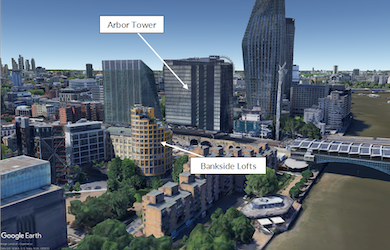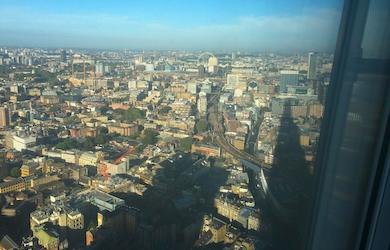When undertaking Daylight Sunlight assessments, the first place to start when determining the impact is to look at windows, including their size, where they are positioned/orientated, and what obstructions are near them. There are, however, two other factors that may complicate matters further when undertaking the analysis: balconies and skylights.
This article takes a brief look at how balconies and skylights can affect the results of the daylight sunlight modelling and detail how our model can calculate these impacts.
Balconies and Daylight Sunlight
Balconies on buildings are not unusual occurrences for residential developments ranging from a few storeys up to what would be considered high-rise. The layout of the balconies will vary, with some being uniform, as shown in the left image of Figure 1 below, and some with non-uniform designs, like in the image to the right. When it comes to the modelling daylight sunlight effects, the former is certainly less complex than the latter, but both present significant additional modelling hurdles to jump through.
Figure 1: Uniform and non-uniform balcony layout design. [1]
In both instances above, if balconies were not considered, the Vertical Sky Component (VSC), Annual Probable Sunlight Hours (APSH), and No Sky Line would all be miscalculated and not representative of the design of the building. Balconies block light, and this means we need to consider the impact of skylight availability coming from above as well as from below. A similar effect can be seen in the context of APSH and No Sky Line. In each case, modelling without balconies would present results that overestimate the amount of sunlight and skylight reaching each room. Therefore, it is important that any model used can consider the presence of balconies.
Skylights and Daylight Sunlight
Skylights have the opposite impact when compared to modelling the effects of balconies on daylight sunlight effects. If skylights are not modelled, then the amount of sunlight and skylight within a development will be underreported and could bring a development below threshold levels, when in reality, the skylight would provide additional lighting. Indeed, most sky models, including the CIE standard, assume that ‘skylight’ is more intense coming from overhead than from near the horizon, and therefore, a window skylight will allow for even greater access to more intense ‘skylight’ than a typical vertical window would. Figure 2 below shows two examples of skylights.
Figure 2: Two skylight designs. [3]
How do we model balconies and skylights?
Pager Power’s daylight sunlight model is bespoke, which means it can be adapted for the assessment of any development, including those with complex balcony and skylight arrangements. For balconies, the model can consider an ‘overhang’ caused by the balcony on the external windows. We can also consider the window being fully enclosed and essentially set back from the exterior. For skylights, the data for the roof windows is simply added to the model. In each case, the whole development, including the consideration of balconies and/or skylights, is then assessed against the skylight and sunlight indicators at the given location to give an overall result considering any existing relevant obstructions in the surrounding area.
Final thoughts
Balconies and skylights can be present in any building type and are common on both single residential properties as well as multi-unit low- and high-rise residential properties. In terms of daylight sunlight assessments, their consideration within the model can have a significant impact on the results, and therefore it is essential that these are considered. When speaking with our technical team, please make them aware of the presence of any balconies or skylights and provide any details you may have on their design.
Speak to an expert
If you are interested in finding out more about our daylight sunlight assessments, follow the link here to make an enquiry, or give us a call on +44 (0)1787 319001.
About Pager Power
Pager Power is a dedicated technical consultancy that has been providing independent guidance and advice regarding solar developments, wind farms, and building developments internationally since 2002.
Our Daylight Sunlight Assessments utilise our own bespoke model that complies with BRE and British Standards guidance to ensure accuracy and compliance with best practices. More information on the guidance can be found here.
Further details about the services we provide can be found here. Pager Power has completed over 1,500 glint and glare assessments, over 1,000 aviation/radar impact assessments, over 500 television and radio reception surveys, and over 500 telecommunications impact assessments.
Finally, a link to our testimonials page can be found here.
References
[1] Images sourced from flickr – left and right. Last accessed on 17th March 2025. Available at: https://www.flickr.com/photos/
[2] Typically only assessed when room dimensions of surrounding buildings are known, otherwise the assessment can lack meaningful accuracy.
[3] Images sourced from flickr – left and right. Last accessed on 17th March 2025. Available at: https://www.flickr.com/photos/





